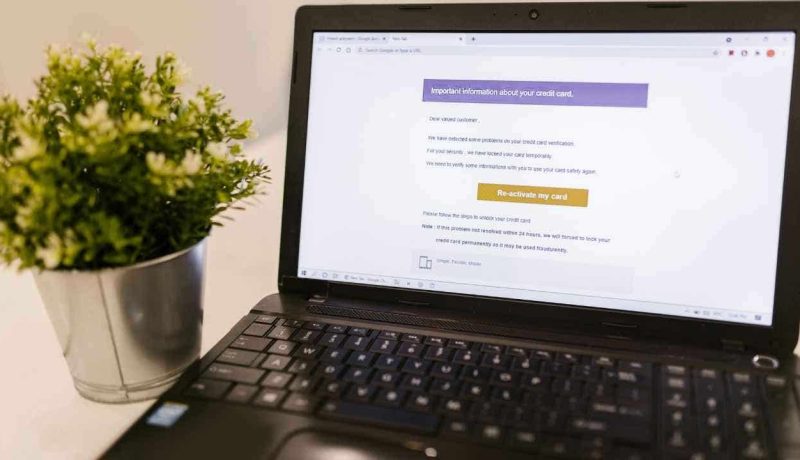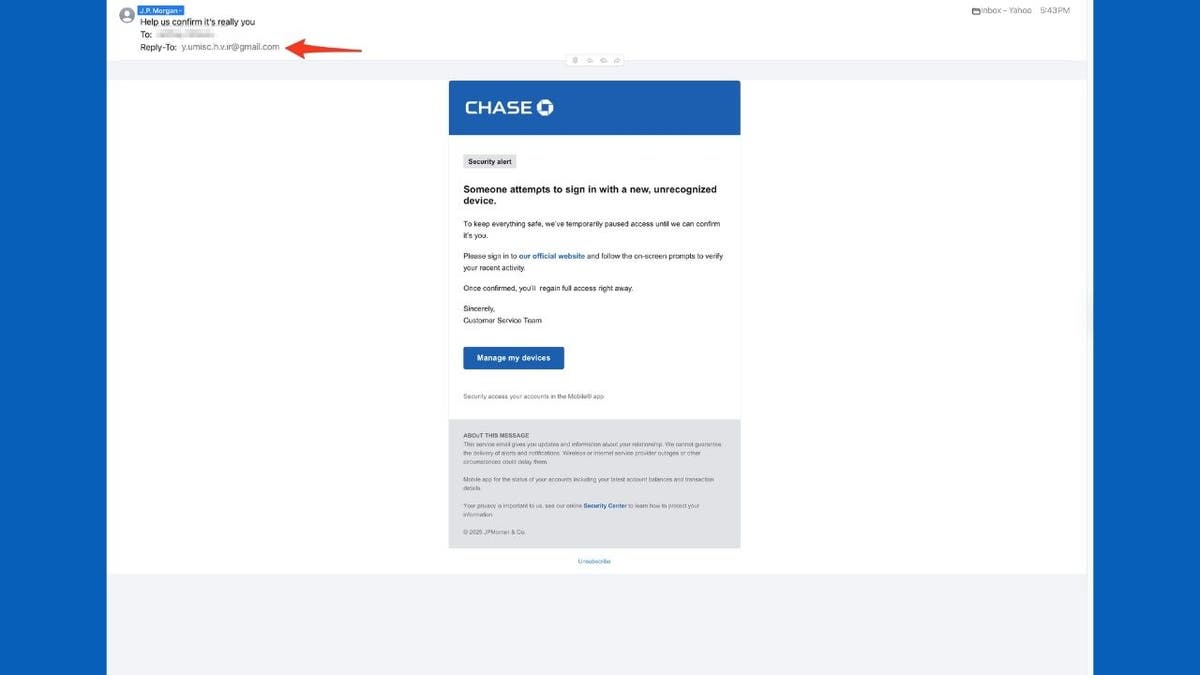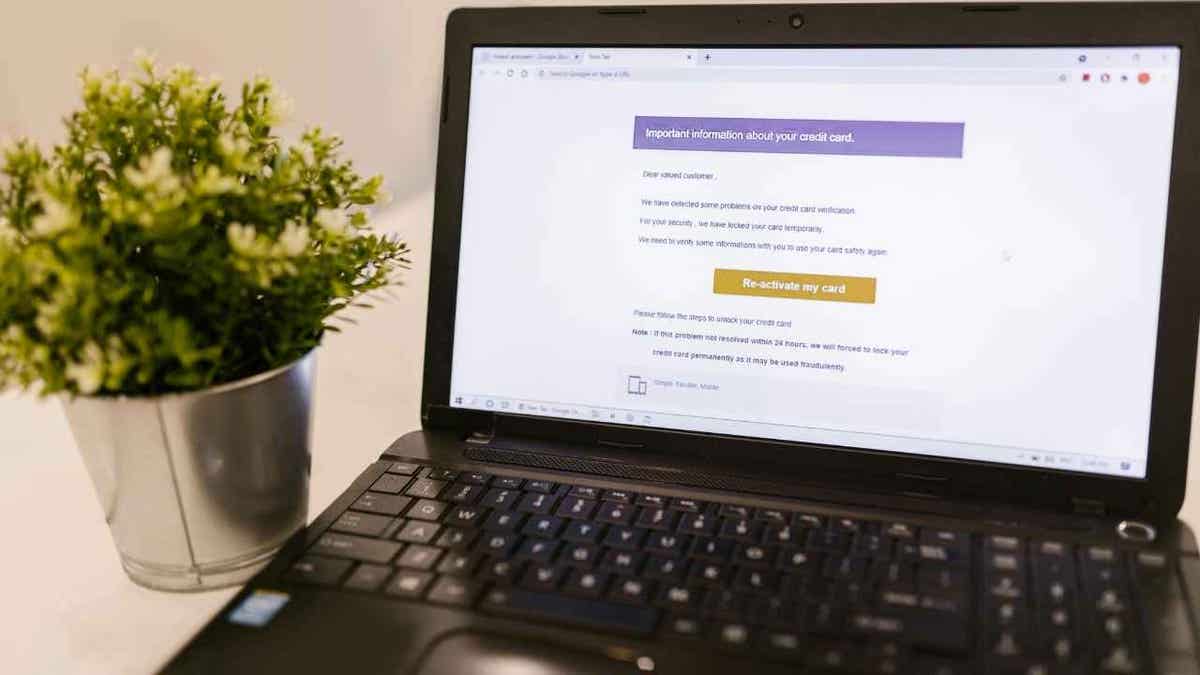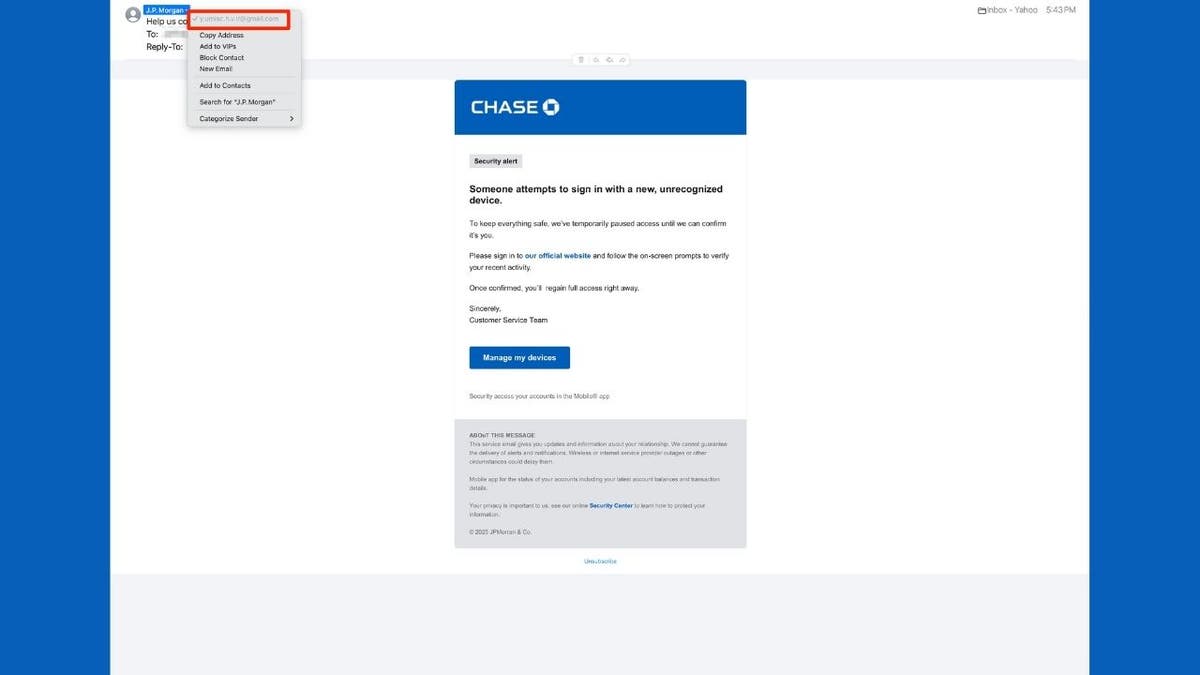
Convincing Chase bank phishing scam email targets customers’ personal data
Table Of Content
- How the bank phishing scam email works
- What happens next is where things take a dark turn
- Signs you’re looking at a bank phishing scam email
- Tips to stay safe from bank phishing scam emails
- 1. Avoid clicking suspicious links and use strong antivirus software
- 2. Use two-factor authentication (2FA)
- 3. Use a personal data removal service
- 4. Strengthen passwords with a password manager
- 5. Keep your software updated
- 6. Pause and verify urgency
- 7. Review email senders carefully
- Kurt’s key takeaways
NEWYou can now listen to Fox News articles!
That bank email in your inbox might look legitimate, but it could be a dangerous scam designed to steal your personal information. We recently received one ourselves, and it’s alarmingly convincing. It warns of an unrecognized device trying to sign in and urges you to “verify your activity” via a provided link. While it appears helpful, this email is anything but safe.
In reality, it’s part of a growing wave of phishing attacks that mimic trusted companies like Chase. These emails are loaded with deceptive links that lead to malware infections, and the consequences can be severe.
Sign up for my FREE CyberGuy Report
Get my best tech tips, urgent security alerts and exclusive deals delivered straight to your inbox. Plus, you’ll get instant access to my Ultimate Scam Survival Guide — free when you join my CYBERGUY.COM/NEWSLETTER
HOW FAKE MICROSOFT ALERTS TRICK YOU INTO PHISHING SCAMS

Actual bank phishing scam email (Kurt “CyberGuy” Knutsson)
How the bank phishing scam email works
This scam starts with what looks like a typical security alert from Chase or another bank. The email claims someone tried to log in from an unknown device. To “protect” your account, it asks you to confirm your identity by clicking a link.
What happens next is where things take a dark turn
Clicking the link launches a fake webpage designed to distract you while a hidden file quietly runs in the background. This file is often an HTA file, a type of HTML application commonly used to deliver malware. It then drops a DLL file onto your computer, essentially a backdoor that opens your system to hackers.
From there, the malware uses a technique called Reflective DLL Injection to inject malicious code directly into your browser’s memory. This allows attackers to:
GET FOX BUSINESS ON THE GO BY CLICKING HERE
- Monitor your keystrokes
- Steal login credentials and credit card numbers
- Gain access to your accounts
- Create long-term backdoors on your system
This scam isn’t just trying to scare you; it’s designed to take full control.

Scam phishing email (Kurt “CyberGuy” Knutsson)
Signs you’re looking at a bank phishing scam email
Scammers rely on urgency and fear to prompt you into quick action. Here’s how to recognize a phishing attempt like this:
- Check the sender’s email address: Hover over the sender’s name to see the actual email address. In our case, “JP Morgan” was linked to a Gmail address, a clear red flag. Legitimate companies don’t use personal email services like Gmail or Yahoo for official communication.
WHAT IS ARTIFICIAL INTELLIGENCE (AI)?

Actual bank phishing scam email (Kurt “CyberGuy” Knutsson)
- Unusual language or grammar: Scammers often use awkward phrasing or capitalization errors like “Security access your accounts.”
- Generic greetings: Real banks usually use your name. Scams often begin with “Dear Customer.”
- Suspicious links: Hover over any link to see the actual URL. If it looks off, don’t click.
- Unexpected requests: If the email urges immediate action, especially involving account access, take a step back.
Tips to stay safe from bank phishing scam emails
You don’t need to be a tech expert to avoid falling for phishing scams. A few simple habits can go a long way in protecting your identity, finances and devices. Here are some essential steps anyone can follow:
1. Avoid clicking suspicious links and use strong antivirus software
Never click on links in unsolicited emails. Instead, type the official website URL into your browser or use the company’s verified app. The best way to safeguard yourself from malicious links that install malware, potentially accessing your private information, is to have antivirus software installed on all your devices. This protection can also alert you to phishing emails and ransomware scams, keeping your personal information and digital assets safe.
Get my picks for the best 2025 antivirus protection winners for your Windows, Mac, Android and iOS devices at CyberGuy.com/LockUpYourTech
2. Use two-factor authentication (2FA)
Enable two-factor or multi-factor authentication on all sensitive accounts. This adds an extra layer of security, making it harder for hackers to break in.
3. Use a personal data removal service
These services help you remove your personal information from data broker sites that scammers may use to craft convincing phishing attacks. While no service promises to remove all your data from the internet, having a removal service is great if you want to constantly monitor and automate the process of removing your information from hundreds of sites continuously over a longer period of time.
Check out my top picks for data removal services and get a free scan to find out if your personal information is already out on the web by visiting Cyberguy.com/Delete
Get a free scan to find out if your personal information is already out on the web: Cyberguy.com/FreeScan
4. Strengthen passwords with a password manager
A trusted password manager helps you create strong, unique passwords for every site and stores them securely so you don’t have to remember them all.
Get more details about my best expert-reviewed Password Managers of 2025 here at Cyberguy.com/Passwords
5. Keep your software updated
Regularly update your operating system, browser and all apps to close security gaps that hackers often exploit. Many phishing attacks rely on outdated software to launch malware, so turning on automatic updates is one of the easiest ways to stay protected.
6. Pause and verify urgency
If an email pushes urgency, like a locked account or an unfamiliar login, slow down. Contact the company directly using a number or email from its official website.
7. Review email senders carefully
Always hover over the sender’s name to check the actual email address. If it ends in something like @gmail.com and claims to be from a major bank, it’s likely fake.
CLICK HERE TO GET THE FOX NEWS APP
Kurt’s key takeaways
Phishing scams like this Chase bank email are getting harder to spot. They look professional, include real logos and mimic the tone of official messages. But with a few safety habits, you can protect yourself from even the most convincing attempts.
Would you click the link without thinking, or would you pause and investigate? Let us know how you handle suspicious emails and whether you’ve seen scams like this in your inbox lately by writing to us at Cyberguy.com/Contact
Sign up for my FREE CyberGuy Report
Get my best tech tips, urgent security alerts and exclusive deals delivered straight to your inbox. Plus, you’ll get instant access to my Ultimate Scam Survival Guide — free when you join my CYBERGUY.COM/NEWSLETTER
Copyright 2025 CyberGuy.com. All rights reserved.





No Comment! Be the first one.